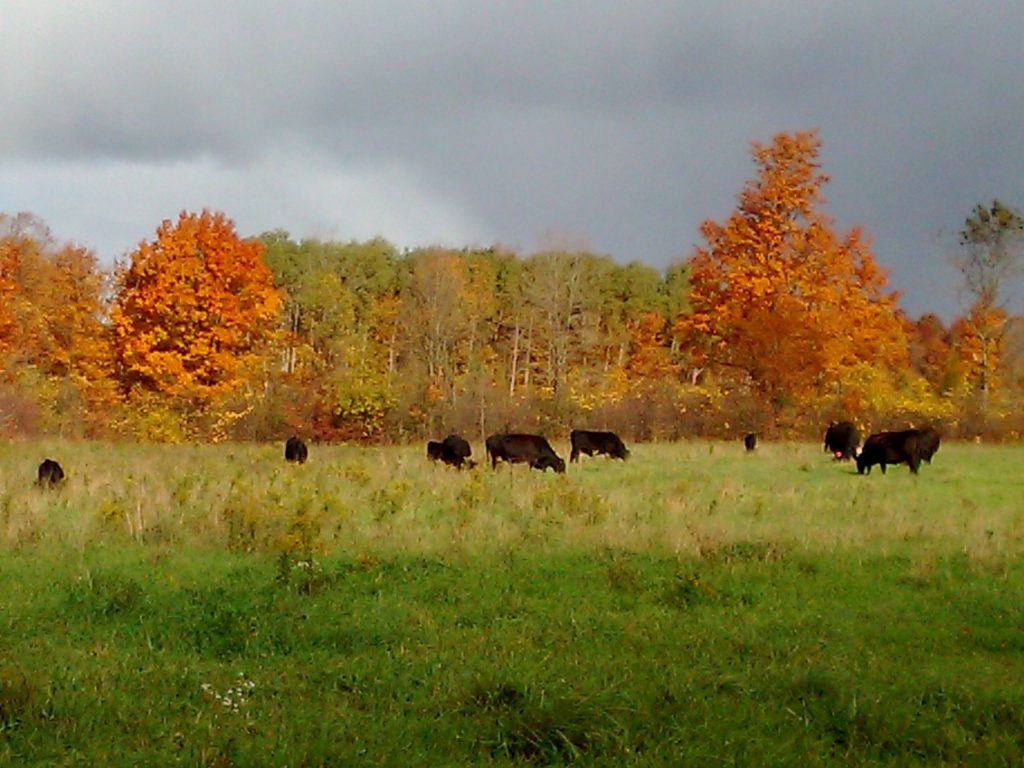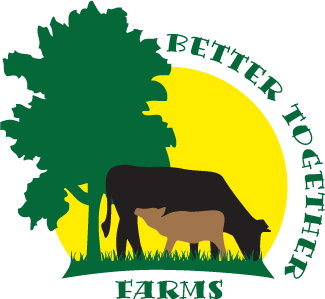The cornerstone of Better Together Farms' regenerative agriculture is our herd of 100% grass-fed certified Angus cattle. See headings below for grass only and Angus.

See Big Picture for Better Together Farms' philosophy of operations.
What is Our Grass Only Beef?
Our cattle only eat hay and pasture. I describe them as "100% grass-fed" or "grass only". Other farmers call this "grass finished". There is a lot of misinformation and disinformation surrounding this subject. Be warned that all beef cattle eat grass at some point in their lives so "grass fed" on its own is a meaningless term.
Corn: Some farmers say that corn is a grass (it is in the grass botanical genus Poaceae) so they can feed corn to their "grass fed" animals. While we don't feed any corn products to our cattle, cattle's digestive systems react like corn is a grass if the corn-based feed is harvested before cobs form; if the corn is harvested after cobs form then the cattle's digestive systems react like they do to grain. We refuse to use corn because corn requires huge amounts of energy to produce and is therefore inconsistent with Better Together Farms' mission of feeding people in humanity's present and future energy descent. (About 4 of the 10 calories of fossil fuel used to produce each calorie of food for sale in grocery stores comes from the production of the synthetic fertilizers required to grow corn.)
The whole truth: we also feed them free-choice salt, mineral supplements, and dried seaweed meal to make sure they get all the nutrition they need. Molasses (non-GMO) is also given as a treat or reward, and as a calorie boost in the coldest periods of winter. The cattle prefer to hang out in trees rather than our portable shelters, so they browse some foliage from our tree lines. Those tree lines have an occasional apple tree and the cattle especially like the windfall apples in the fall to put on some calories in preparation for winter.
Grass only beef is NOT a commodity: In Steak, Mark Schatzker found that the best steak he had was grass only and the worst steak he had was grass only. There is both art and science in raising grass only beef because ecosystems are way too complex and varied to be adequately described by science currently. In fact the pedosphere (which comprise the ecosystems where soil meets air) is the most complex ecosystem on planet earth. I would need a separate web page to document all I consider in deciding each day where to put our cattle and how much area to give them. And I need to be mostly right every single day because if the cattle experience too much stress at any time during the 24 to 30 months before slaughter then their meat will not taste as good or be as tender. You are paying for a lot more labour and a lot more management know-how.
Know your farmer = know your food. As usual if you really want to know what you are eating then ask your farmer. There are certifications for these sort of things but I have enough work and spend enough money taking the best care I can of our cattle. Climate change is changing the environment where my cattle live and impact the livestock in significant and unpredictable ways. Requirements for certifications decrease flexibility and therefore increase my risk.
Impacts of Feeding Only Grass
Impacts On Our Customers
You are what you eat: If you think about it, this saying is recursive meaning that you are what your food eats. As economics drive further "efficiencies" in production, farmers look to "wastes" from other industries as cheap sources of cattle feed.
Impacts On the Environment
To be a good (grass only) beef farmer you need to be a good grass farmer.
Holistic grazing, like we do here at Better Together Farms, frequently move the cattle (about every other day) during the grazing season so that the herd emulates the impact of large herds of ruminants on prairies and grasslands: a brief impact followed by a much longer recovery period. (This emulation of nature is sometimes called bio-mimicry or agro-ecology.) Cattle and grasslands co-evolved a symbiotic relationship over millions of years before cattle were domesticated, so "cows eat grass" is true to the same extent that "grass is meant to be grazed". (Go to our Cattle and Grass page for a description of how each helps the other.) So while cattle do burp methane, the overall impact of the ecosystem cattle enable is to take greenhouse gasses out of the environment.
Impacts On the Animal
Grain raises the pH of the rumen/gut creating a more favourable environment for the proliferation of E.coli bacteria.
What are certified Angus?
Angus cattle: Back in the 1980s Angus breeders were quicker than others to take advantage of genetics to produce superior beef (and superior cattle). To capitalize on this, the Canadian Angus Association created the Canadian Angus Indicator program. This program is used within the beef industry to identify animals which have a minimum of 50% Angus genetics. Every cattlebeast born at Better Together Farms satisfies the program requirements because we only breed our cows to purebred Black Angus bulls. In 2021 we demonstrated our bloodlines to the Canadian Angus Association in order to purchase animal identification tags that assert our genetics.
Angus beef: As far as I can tell, the Canadian Angus Association does not endorse or support any claim to Angus beef. Until June 2020 their website said "Many beef products in grocery stores and restaurants are labelled as Angus beef. There is no way to limit the use of the word Angus in Canada." So it comes back to if you want to know your food then know your farmer.
Why Angus?
Every beef farmer will argue that their breed or crossbreeding program is the best. I am less dogmatic than many but here is why I am moving our herd towards purebred Black Angus.
Crossbred versus purebred herd: Most beef herds are crossbred (mixes of breeds) to raise meat at lower cost through hybrid vigour (heterosis) and minimize risk of the genetic problems that can arise from inbreeding. Based on the studies I have read I believe these cross-breeding programs sacrifice meat consistency in pursuing these goals. Upside: if I'm right you will get more consistent beef year after year from me than from a crossbred herd. Downside: if I'm wrong it will take several years to fix the problem (but only one generation). Good thing our first grass only beef is excellent.
Moving towards purebred herd: Purebred animals are expensive; a fellow cattleman routinely pays at least $15,000 per bull. It is much cheaper to buy crossbred cows that are at least 50% the desired breed and then breed them to a purebred bull. That way the first generation born on the farm is at least 75% (3/4) the desired breed, the next generation will be 87.5% (7/8) the desired breed, the third generation will be 93.75% (15/16) the desired breed, and so forth. This approach also has reduced risk of genetic problems in the early years, so you rely more on your ability to manage genetics as your experience and knowledge increase.
Tiny herd: We can put a maximum of 40 acres into pasture on our farm. This is tiny in the world of beef farming. Further because our soil was so depleted from field cropping when we started we needed ten times the area per animal of industry standard stocking rates. These land constraints mean we are small and will always be small. Being small means you probably want to rent rather than buy bulls. 2/3 of beef cattle are Angus and the vast majority of those are Black Angus, so Black Angus is the breed with the broadest available genetics.
The walk versus the talk: I am a member of the Heritage Livestock Canada and totally support maintaining a wide range of genetics, but Better Together Farms' mission of finding a regenerative way to feeding people in a world of energy descent requires us to be a receiver of genetics rather than a producer of genetics. Consequently we chose the most popular breed that does well on just grass.
